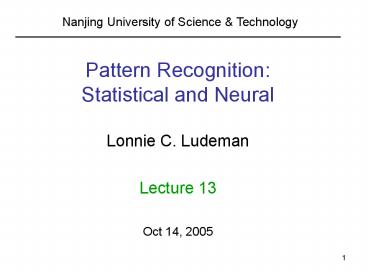Pattern Recognition: Statistical and Neural - PowerPoint PPT Presentation
Title:
Pattern Recognition: Statistical and Neural
Description:
Calculation of Probability of error for the 2-class Gaussian Cases ... 2. Calculation of P(error) for two class case : special cases ... – PowerPoint PPT presentation
Number of Views:57
Avg rating:3.0/5.0
Title: Pattern Recognition: Statistical and Neural
1
Nanjing University of Science Technology
Pattern RecognitionStatistical and Neural
Lonnie C. Ludeman Lecture 13 Oct 14, 2005
2
Lecture 13 Topics
1. Multiple observation Multiple class example
(review) Sufficient statistic space and
Likelihood ratio space 2. Calculation of P(error)
for 2-class case several special cases 3.
P(error) calculations examples for special cases
2-class case
3
Example 1 Multiple observation - multiple classes
Given the pattern vector x is composed of N
independent observations of a Gaussian random
variable X with the class conditional densities
as follows for each component
A zero one cost function is given as
Find
(a) the Bayes decision rule in a sufficient
statistic space. (b) the Bayes decision rule in
a space of likelihood ratios
4
Solution (a) Since the observations are
independent the joint conditional density is a
product of the marginal densities and given by
for i 1, 2, 3 and mi i, i1, 2, 3
Bayes decision rule is determined form a set of
yi(x) defined for M3 by
5
Substituting the given properties gives
The region to decide C1 is found by setting the
following inequalities
Therefore the region R1 to decide C1, reduces to
the x that satisfy
6
Similarly the regions R2 and R3 become
Substituting the conditional densities, taking
the ln of both sides and simplifying the decision
rule reduces to regions in a sufficient statistic
s space as follows
7
Which is shown below in the sufficient statistic
s space
s
An intuitively pleasing result !
8
(b) Bayes Decision Rule in Likelihood ratio
space M-Class Case derivation
We know that Bayes Decision Rule for the M-Class
Case is
if yi(x) lt yj(x) for all j i Then decide
x is from Ci
M
where yi(x) Cij p(x Cj) P(Cj)
j1
9
Dividing through by p(x CM) gives sufficient
statistics vi(x) as follows
LM(x) p(x CM) / p(x CM) 1
Therefore the decision rule becomes
10
Bayes Decision Rule in the Likelihood Ratio Space
The dimension of the Likelihood Ratio Space is
always one less than the number of classes ( M -
1)
11
Back to Example Define the likelihood ratios as
We have already determined the region to decide
C1 as
Dividing both sides of the inequalities by
p(xC3) gives the following equations in the
Likelihood Ratio space for determining C1
12
The other regions are determined in the same
fashion giving the decision regions in the
likelihood ratio space
13
Calculation of Probability of error for the
2-class Gaussian Cases
Special Case 1
We know Optimum Bayes Decision Rule is given by
14
The sufficient statistic Z conditioned on C1 has
the following mean and variance
15
The conditional variance becomes
thus under C1 we have
Z N( a1, v1 )
a1
v1
16
Similarly the conditional mean and variance under
class C2 are
The statistic Z under class C2 is Gaussian and
given by
thus under C1 we have
Z N( a2, v2 )
17
Determination of the P(error)
The total Probability Theorem states
where
18
Since the scalar Z is Gaussian the error
conditioned on C1 becomes
19
Similarly the error conditioned on C2 becomes
Finally the total P(error) becomes for Special
Case 1
20
Special case 2 Equal scaled identity Covariance
matrices
Using the previous formula the P(error) reduces
to
where
(Euclidean distance between the means)
21
Special case 3 Zero- one Bayes Costs and Equal
apriori probabilities
Using the previous formula for P(error) gives
22
Special Case 4
Then
23
Example Calculation of probability of Error
Given
Find P(error) for the following assumptions
24
(a)
Solution
25
(b)
Solution
Substituting the above into the P(error) gives
26
(c)
Solution
Substituting the above into the P(error) gives
27
(d)
Solution
Substituting the above into the P(error) for the
case of equal covariance matrices gives
28
(d) Solution Continued
29
Lecture 13 Summary
1. Multiple observation Multiple class example
(review) Sufficient statistic space and
Likelihood ratio space 2. Calculation of P(error)
for two class case special cases 3. P(error)
calculations examples for special cases - 2 class
case
30
End of Lecture 13

